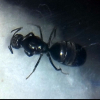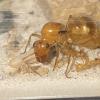Hi guys!
Sorry not being much active here lately but I'm currently overwhelmed with life, including keeping my about a dozen Messor colonies and their escape artists.
I still have a lot of formicaria to do for them but that process is covered enough.
What I need is some hints for my Pheidole pallidula's formicarium.
As I only have one colony, I want to do this right.
They are really really tiny, about 1 millimeter (1/25") in size. I call them my 1x2 pixels ants.
But they are impressively ferocious, are starting to grow up in numbers and soon will want to take over the world. Their test tube will be small soon, and it has mold on the cotton, so it's time to give them a new home.
Since they are so tiny, I was considering making an acrylic formicarium but I've found no hints around on how to make them without a laser cutter or CNC machine.
My idea would be stacking a few layers of acrylic and then carve the chambers with an electric tool but I don't think that will be feasible and most probably will not lead to a nice and well done job.
So I'm considering gypsum (or molding plaster, I can't find an exact translation for it, sorry).
This has been working fine for my Messors.
But for the Pheidole I'll have to mix the plaster as hard as I can to make it a bit less chewable.
If they are anything like the invasive Pheidoles I have on my house, they chew through everything, I believe underneath the floor I have huge colonies of them, they even chew out holes between the tiles in interior brick and mortar walls and go for my cat's food... (and even claimed several founding queens, including one inside a plaster formicarium!)
So, ruling out the acrylic, would a (more hardened mix of) plaster formicarium with thicker walls be good enough for Pheidole pallidula?
Also for what I've read, can you confirm that plaster is a suitable material for this species, humidity keeping wise?
I'm planning to pour a mold of a container, carve out the chambers, passages and the out world (in an all-in-one block), leave a hole for a moisture piece of sponge, paint the outside with non toxic acrylic paint, and use a piece of acrylic as a lid secured with magnets. (nothing new, really)
I've read this somewhere on this forum: (sorry I can't find the original post now, so I can't credit whomever wrote it)
Quote
Make sure the grout mix ratio is similar to 1:2:1 water, unsanded grout, crushed perlite. Make sure you crush the perlite until it's a fine powder.
Does it make any sense using crushed perlite (I have never used it) in a formicarium for this species?
My biggest challenge is making it escape proof for such tiny ants.
In one of my formicaria I've found out that if I allow the acrylic paint to dry out but not fully cure and place the acrylic over it secured with magnets, after some days I can remove the magnets and the acrylic lid will be sealed against the painted border and even a bit hard to remove. So this seal is taken care of!
For air exchange in the formicarium, I must find the finest metal mesh and hot glue it around a hole on the lid, to make it escape proof.
Any hints on how can I make a feeding hole that won't be an escape route?
For Messors I've drilled a hole on the lid and cover it with a cotton ball, but they insist in pulling it out from the inside fiber by fiber, and when I pull the cotton out I can have one ant attached to it, and when I try to gently put it back in 2 more will escape, and then it's the circus act you know (Benny Hill music theme intensifies...)
Also, size for the near and far future. How big should the formicarium be for this exponential growth species?
I've seen formicaria that have a way to block out some chambers until the colony grows and then some more room is given to them so there's always a good ratio between population and living area. But doing this for this species would introduce a very potential escape route, the blocking pieces would have to fit very tightly and there would need to be a way to remove the blocking piece and cover the whole it left behind very well.
Would there be any problem from giving them too much room initially? Would they start to use chambers as dumpsters instead of the out world, like Messors do?
So if you could share any tips and hints, I'd be really appreciated, as usual.
Thanks guys!


















